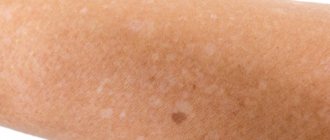Vitiligo (leukoderma) is a peculiar skin disease characterized by depigmentation, manifested in the form of light spots throughout the body, including the face. They appear due to the lack of melanin production. The disease can develop in people of any age, but the largest percentage affects children and adolescents. Vitiligo in children occurs with certain characteristics.
The disease itself is not contagious or dangerous, but it does bring some discomfort and cosmetic defects. This pathology is characterized by gradual development and a long course.
As the child gets older, the spots increase in size and take on different shapes. If foci of vitiligo are localized in open areas of the body, then under the influence of sunlight, dryness, thickening of the skin in the area of depigmentation, as well as peeling and redness may appear. It is worth noting that sun tanning causes spots to become more noticeable.
Treatment of vitiligo in children with Melagenin Plus lotion
Pigmentation or hyperpigmentation of the skin - what is it?
In fact, there is nothing wrong with this term and such a defect has absolutely nothing to do with any diseases.
The dictionary definition states that this can be called the uneven distribution of coloring pigments over the surface of the epidermis. In our case, we are talking specifically about a substance such as melanin, produced by a certain type of cell (melanocytes). Excessive accumulation or deficiency can cause hyperpigmentation or, conversely, tissue discoloration. This is how dots and even extensive formations appear, which are clearly visible to the naked eye. However, not only this substance has coloring ability; there are others. These can be lipochromes, bilirubin, lipofuscin and many others, which are products of cell metabolism.
Stages of childhood vitiligo
The disease in children has the same stages of development as in adults:
- Initial. First, one small spot appears, which may not increase in size for a long time and is a single spot.
- Progressive. It is characterized by the appearance of a large number of new spots over several weeks and an increase in the size of old ones.
- Repigmentation. This stage is diagnosed if no new foci of the disease have appeared for several months, and existing spots darken, do not grow, and in some places completely disappear.
Parents should know that vitiligo is prone to recurrence. If you manage to completely get rid of the signs of the disease, it may return after some time.
Pigmentation (hyperpigmentation) in adults and children
People often wonder why and what causes pigment spots to appear on the body. There can be quite a few reasons, most of them will be answered in our article. Heredity may be a major factor. In such cases, visual defects appear from birth or at a very young age, because information about them is embedded in the DNA.
Therefore, there is no big difference when a person decides to deal with the problem. In the most extreme situations, when this seriously spoils the appearance, and, consequently, the quality of life, treatment with modern surgical techniques, for example, laser resurfacing, is indicated. However, these are extreme measures, and alternative options can always be found. Laennec Skincare – LNC offers to transform the skin at the cellular level, prevent and completely eliminate hyperpigmentation.
Etiology and pathogenesis
Coffee stains on the skin usually indicate that the patient has neurofibromatosis type I , a multisystem disease characterized by spots on the back, neck, and axillary areas, as well as skeletal dysplasia, benign or malignant tumors of the nerve sheaths (neurofibromas). The average incidence of neurofibromatosis type I is 1:3000. Its main causes are considered to be mutations or deletions (loss of a section) of the NF1 gene. This gene is responsible for the production of neurofibromin 1, a protein that suppresses the occurrence of tumors of the nervous system. A decrease in its synthesis leads to the appearance of neurofibromas and other clinical signs of the disease.
Coffee stains on the skin can also occur for the following reasons:
- Albright-McCune-Sternberg syndrome - premature puberty, multiple fibrous osteodysplasia, skin hyperpigmentation.
- Bourneville-Pringle disease - tuberculous sclerosis; a rare genetic disease in which multiple benign tumors form in organs and tissues.
- Fanconi anemia is manifested by a complex of symptoms, the most serious of which are hematological disorders and tumors.
- Coffin-Siris syndrome is characterized by aplasia or hypoplasia of the distal phalanx or nail on the fifth toe, developmental delay, mental retardation, coarse facial features, etc.
Cafe-au-lait skin spots may be the result of RAS mutations —changes in the RAS family of genes and proteins. These are small GTPases (enzymes that bind and hydrolyze guanosine triphosphate, an energy substrate for RNA), which are involved in signal transmission from outside the cell and regulate cell division. Some RAS mutations promote the emergence and metastasis of tumors.
In 50% of patients, the genetic mutations responsible for the appearance of coffee spots on the skin occur spontaneously. That is, the hereditary mechanism of transmission of the disease in this case is of indirect significance.
As for pathogenesis , coffee spots appear against the background of an increase in melanin production and the presence of giant melanosomes in the skin. In patients with neurofibromatosis type I, the number of melanocytes in age spots increases more significantly compared to other diseases.
Hair and eye coloring
Few people know that the color of the iris also directly depends on the amount produced, the depth of occurrence and the total mass of the main coloring pigment. The shade of the iris becomes darker when there is more melanin in the body and vice versa.
The situation with hair is approximately the same; the lighter it is, the fewer compounds are produced. Over the course of life, due to various internal and external circumstances, its release may intensify or subside due to various pathological or physical phenomena.
Main symptoms
In general, symptoms of vitiligo in children begin to appear by the age of 9-10 years. At the same time, the clinical manifestations of the disease in infants and older children may be different and develop depending on the general condition of the child. Initially they are small in size, round in shape and pinkish in color. As the child grows, the spots also increase in size, take the form of blots and become milky white.
As a rule, depigmentation does not cause pain. However, too much sun exposure can lead to dryness, irritation and sometimes itching. If a child scratches the spots, it can cause infection of the wounds, as well as their inflammation.
If leukoderma is localized on the scalp, then in these places the hair becomes discolored and turns gray. In this case, the affected areas are less responsive to cold or heat. The disease does not affect the internal organs and systems of the body.
Face and body
There are a huge number of different reasons why skin hyperpigmentation appears. It can occur not only on the surface of the face, but also on the arms, back, legs, and abdomen. This may be due to genetics, various autoimmune disorders, excessive uncontrolled exposure to ultraviolet rays, insurmountable external circumstances, for example, the climatic characteristics of the region of residence, the environmental component, smoke or dust in cities.
Darkening on the stomach or back, on the arms or legs can appear after an inflammatory process in the epidermis. For some, insect bites cause light or dark areas of varying sizes that last a long time. Why is this happening? There are many prerequisites, they are worth discussing separately.
Causes of age spots on the body
The mechanism is simple - melanocytes participate in tissue healing, help rapid regeneration, and stop oxidation from the effects of free radicals. However, “working” on a certain place, they at the same time significantly darken it, which is why a stain is formed.
Problems with improper redistribution of melanin can arise with long-term use of certain medications. In the process of treating one imperfection, a person also earns an additional one - ugly darkened or light areas. Antibiotics and oral contraceptives also sometimes cause different types of darkening of the surface of the dermis.
Anti-age drugs
Curacen Essence (20 fl x 2 ml)
Laennec – solution for injection
Bb Laboratories – Serum “Arcanum”
Premium set “Ideal facial skin. Healthy tone"
Types of skin pigmentation disorders
They can be either primary (congenital) or secondary, that is, they are actually a consequence of some process in the body or outside it. The intensity may increase or decrease over time.
Cutaneous-ocular albinism
This heterogeneous disease can most often be diagnosed in the fetus while still in the womb. If the diagnosis was not established in time, then the disease manifests itself immediately after birth. The main signs are depigmentation of the skin (milky-white tint), iris, hair, and other things. Often accompanied by deafness and even epilepsy, actinic (solar) keratosis.
People with this diagnosis have a high risk of developing tumors in the dermis, for example, under the influence of sunlight. Therefore, doctors recommend them powerful photoprotective creams, as well as other drugs containing many retinoids.
Hyperpigmentation
This phenomenon consists of a special concentration of skin pigment, a significant increase in its color compared to normal. It is caused by its excessive production due to various processes in the body. The main shade of the epidermis directly depends on melanocytes, which are responsible for the production of melanin in special formations called melanosomes. Tyrosine and its derivative tyrosinase, which is related to copper, are responsible for the synthesis.
First, promelanin appears, which, under the influence of another enzyme, oxidase, is already converted into the final substance. From its immature cells, melanocytes are produced, which are found mostly in the basal epidermal layer. It is noteworthy that representatives of the light-skinned race have exactly the same number of them as dark-skinned people. However, the coloring component penetrates into all layers of the dermis, including the stratum corneum.
The appearance of hyperpigmentation: hyperchromia
Sometimes it can be limited, that is, appear only in certain places. Such disorders also include chloasma and maculae, commonly called freckles.
These formations can be regular or irregular in shape. Most often they are yellowish, yellow-brown or even brownish-brown. They can be located in the facial area (in the majority of cases), but also dispersed throughout the body (disseminated position). The main cause of this skin defect is genetics.
Freckles
Maculae first appear in children of primary school or preschool age, most often after prolonged exposure to direct sunlight. These are neat, oval or round, brown or red spots, the size of which can vary between 1-10 millimeters in length. For many people with this feature, pigmentation is clearly visible in spring and summer, but in the cold season it fades and becomes barely noticeable.
Such macules do not pose any threat to health, and they are diagnosed using a visual examination. However, it is still better to maintain a certain degree of dermal care. In warm weather, you should definitely use creams and ointments with photoprotective ingredients and SPF filters. It is not customary to remove freckles, but many cosmetologists recommend whitening compounds and keratolytic agents.
For the qualitative elimination of such defects, the injection and non-injection drug CURACEN is effective, which can “override” the main prerequisites for starting the process of melanogenesis. After testing, it turned out that it can even be used for recovery after various aggressive procedures (peelings, scrubbing, acid exfoliation). Its cosmetic non-injection form – CURACEN Essence – is also perfect for this. Among the best-proven tone-evening products are specialized preparations from the brands Bb Laboratories, Laennec Skincare - LNC, PlaReceta. They are developed by pharmacists, which guarantees their effectiveness and safety.
Chloasma
Melasma, cutaneous melanosis or melasma - all this refers specifically to this phenomenon and is an excessive deposition of a dye in the epidermis. Usually it looks like symmetrical formations of irregular shape, located mainly on the face. They are often brighter and darker than freckles and have a very indirect relationship to genetics. There are only two reasons for the appearance of chloasma:
- Excessive accumulation of phagocytes in the papillary layer, which capture melanin coming directly from the epidermis and absorb it.
- Increased concentration of the coloring component in the cells of the basal layer.
Such formations occur, which do not appear on the surface in any way, due to friction, during pregnancy and gynecological diseases in women, due to pressure or due to the use of certain oral contraceptives.
Hypopigmentation
The process is characterized by the fact that a person develops very weakly pigmented skin. The reason usually lies in the insufficient production of that same melanin, or its complete absence, for which they even came up with a special term - depigmentation. Its total deficiency is considered albinism, and its partial deficiency is itself a subtype of hypochromia.
Vitiligo
Scientists have not yet figured out where this disease came from and what causes it. However, it is thoroughly known that this is an acquired anomaly, which is in no way related to genetic mutations, but is related to such characteristics. Those who suffer from vitiligo often have problems with the endocrine system (adrenal glands, thyroid gland, pituitary gland).
The disease looks like whitish, colorless spots all over the body, growing and merging together. Sometimes before this you can observe erythema, that is, some redness and mild inflammation. Sometimes even hair on their surface becomes discolored, but not always. Sensitivity in the affected areas increases, inflammation from the sun often occurs, redness and itching appear.
Doctors do not yet have any effective treatment for vitiligo. But therapy is always prescribed to reduce the rate of development of spots, as well as unpleasant symptoms. If the defect interferes with the appearance and is located on the face, it is recommended to use various cosmetics, for example, decorative dyes in general, and dihydroxyacetone in particular.
Incomplete albinism
A cutaneous-ocular hereditary disease can be complete, in contrast to a purely cutaneous one, or incomplete. It is characterized by a lack of color and is genetic, that is, congenital in nature. Main signs:
- Translucent iris of the eyes.
- Completely whitish or unusually light hair.
- Hypopigmentation of the fundus.
- Hypomelanosis or complete absence of color.
- Acute reaction to too bright light.
There are several undesirable consequences that can occur with this disease. The first is a significant deterioration in vision, and the second is complete intolerance to light. That is, a person simply cannot be in the sun even for a limited time. There is no treatment that completely cures albinism, but all unpainted areas should, if possible, be hidden from direct ultraviolet rays and regularly treated with high-quality protective agents.
Tuberous sclerosis
This is a genetic disease that is transmitted as a dominant autosomal trait. In almost everyone who suffers from it, it manifests itself in the form of spots devoid of dye, located mainly on the buttocks and torso. The pathology appears around the fourth year of life and is characterized by seizures, sebaceous adenoma and even mental retardation.
The shape of depigmented spots is oval, but can be elongated, and the number is from one to several dozen. Additionally, they can be placed across the body, as well as along the arms and legs. Diagnosis is most often carried out using a CT scan, and relatives who have similar marks or have seizures of unknown origin are also checked.
Neurofibromatosis
Recklinghausen's disease is also inherited, like the previous one. Most often it first appears in children around 3 years of age as small pale yellow-brown or beige spots on the body, arms and legs. Their diameter can easily reach 10-15 centimeters, but there are also small ones, up to 1-3.
Moynihan syndrome
Sometimes this disease is poetically called “leopard” and it is not at all accidental. Pathology is also transmitted through genes in a dominant manner. With it, the entire surface of the body is usually covered with limited brownish areas of small size, in which the melanin content is very high. In this case, the syndrome is accompanied by other symptoms:
- Growth retardation compared to peers.
- Pulmonary artery stenosis.
- Severe genital pathologies.
- Deformation of the face, disruption of normal coloring.
- Deafness.
Chloasma of pregnancy
The main sign and symptom of this disease are hypermelanotic areas on the epidermis, that is, ordinary dark spots. Interestingly, similar darkening also occurs in men. It occurs more often in those who have previously taken oral contraceptives.
Doctors recommend the use of vitamin C, nicotinic and folic acids, as well as the use of external local remedies, such as natural keratolytics and creams with a whitening effect (diluted citric acid, juice or vinegar, hydrogen peroxide).
Pigmented papillary skin dystrophy
The reasons may lie in the development of this disease, which is also called acanthosis nigricans. It is expressed in brownish and brownish-brown spots that have a velvety rather than smooth surface. This phenomenon is often observed in those who suffer from various types of oncology, diabetes mellitus, Cushing's syndrome, Addison's disease, pituitary adenoma and others.
Urticaria pigmentosa
Patients symptomatically develop spots and papules, mostly not turning into pustules, of a reddish-brown or yellow-brown hue. In infants, this type of disease occurs spontaneously and most often goes away on its own, but sometimes after many years. Such pathologies are treated by prescribing antihistamines, although no special effect can be expected.
Types of childhood vitiligo
Depending on where the foci of depigmentation are distributed, the following types of disease are distinguished:
Type A (Generalized appearance)
This type is characterized by a long course of the disease. Has the following forms:
- Acrofascial. It is characterized by damage to the distal parts of the limbs.
- Universal. Quite rare in children. Characterized by damage to a large area of skin (more than 80%).
- Mixed. Includes several subspecies; spots are localized over the entire surface of the body, including the head.
- Vulgar. Develops in two or more areas of the body.
Type B (Localized view)
The following forms are distinguished:
- Focal. Vitiligo spots are located only on one side of the body. This type of disease does not progress or spread.
- Zosteriform. It is characterized by a grouping of small lesions in one area of the body.
- Segmental. Depigmentation spreads along the location of large nerves and plexuses.
- Mucous. The spots are localized only on the mucous membranes, as well as on the genitals.
Treatment
There are various methods to get rid of unwanted coloring. Their choice should primarily depend on the pathology itself, the person’s age, and whether he or she has any other problems. Therefore, first of all, it is necessary to carry out a competent diagnosis, which is impossible without special equipment and experienced specialists.
Cosmetical tools
If the unwanted coloring is not a consequence of any disease, then you can use some cosmetic preparations. Effective creams and masks usually contain:
- parsley or jojoba extract;
- arbutin;
- kojic acid;
- vitamin C;
- hydroquinone.
It would be worth repeating that you should use any means only after consulting a doctor.
Cosmeceuticals
In addition to cosmetics, you can purchase effective, safe and high-quality placental preparations to eliminate various skin defects.
- Bb Laboratories - the line is highly effective due to the combination of biologically active substances, peptides, herbal extracts, hyaluronic acid and other components.
- GHC Placental Cosmetic is a series of products that saturates cells with beneficial biologically active compounds, activates the synthesis of collagen and elastin fibers, improves the regeneration process, and reduces wrinkles.
- PlaReceta & PiloPla - the line fights the signs of facial aging, restoring the dermis. The products are especially aimed at those with sensitive, dehydrated, flaky skin, providing effective care and maintaining youth.
- LAENNEC SkinCare - LNC is a placental and vitamin line aimed at eliminating age-related changes. It also helps in restoring the condition of the skin after photodamage. The products restore an even complexion, improve the condition of the skin during inflammation and prevent the formation of wrinkles.
Anti-age drugs
Bb Laboratories – Hyaluron-elastin-collagen extract
Laennec – solution for injection
Curacen Essence (20 fl x 2 ml)
Two-phase placental serum concentrate
Laser skin resurfacing
Often, girls and women choose similar salon procedures that help to quickly and without a trace cope with certain types of skin defects. The laser penetrates deeply into the epidermis and destroys melanin, eliminating everything quickly and safely. Problems usually do not arise after such “cleaning”, but you should only contact reliable and trusted specialists.
What does Dr. Komarovsky say: are age spots dangerous?
The famous pediatrician, Dr. Komarovsky, has repeatedly touched upon the topic of moles, vitiligo and other pigmentation disorders in childhood in his speeches. The doctor says that areas of hyperpigmentation need to be treated with special caution - because cancer cells can develop in them. But this is not a reason to immediately remove moles if they appear. Komarovsky says that the best way to prevent skin cancer (melanoma) is to constantly monitor the condition of nevi. A well-known doctor insists on a monthly examination of the skin, and moles in hard-to-reach places (in the groin folds, armpits, on the scalp) should not be ignored. In order to remember the main signs that it is time to see a doctor, the doctor suggests examining each mole according to the algorithm. This is an abbreviation that stands for:
- asymmetry (should not be observed);
- the edges of the mole (should be clear and even);
- color (the mole should be uniform);
- size (“safe” nevi in diameter do not exceed 6-7 mm);
- dynamics (rapid progression and growth should not be observed).
If a child has a tendency to develop age spots, you need to keep a notebook in which you write down all the data about each mole every month. If you do this regularly and carry out proper examination, you can detect skin cancer in the early stages.
Pigment spots in children are a cosmetic defect, but, in most cases, it does not cause any inconvenience. Often, in order to avoid the progression of tumors and the appearance of complications, it is enough to monitor their condition, undergo timely examinations by a pediatrician, and also protect the skin from the sun and other irritating environmental factors.
https://www.youtube.com/watch?v=Sw0g5JDVlLE









